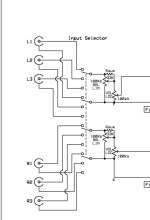Hi All,
I have a Bottlehead Smash that I built a few years ago. I want to remove the balance pot and instead use separate L/R volume pots. The schematic for the input/volume/balance portion of the circuit is attached. In my simplistic way of thinking, I can just take out the balance pot and wire in separate volume pots, but would 100K volume pots still be correct? And do I still need the 33K resistor? Just not fully understanding the interplay between the volume pot and balance pot.
I have a Bottlehead Smash that I built a few years ago. I want to remove the balance pot and instead use separate L/R volume pots. The schematic for the input/volume/balance portion of the circuit is attached. In my simplistic way of thinking, I can just take out the balance pot and wire in separate volume pots, but would 100K volume pots still be correct? And do I still need the 33K resistor? Just not fully understanding the interplay between the volume pot and balance pot.
Attachments
You do deserve an answer.
This one is a bit long, but read all the way to the end anyway.
If all the signal sources have low output impedance when compared to the 100k potentiometer (volume control), then . . .
When the pot is adjusted to 50k, the wiper output impedance is 25k.
The grid of the input tube will see 25k driving impedance.
Lets take an example of one worst case grid input impedance:
A 12AX7 has grid to plate capacitance of 1.7pF.
Because of the large Miller Effect capacitance, I will not include (not worry) about the grid to cathode capacitance of 1.6pf.
If the plate has a constant current source plate load, the stage gain might equal u = 100. (yes, it will be lower than 100, because the plate has to drive the next stage's grid resistor, Rg; it is in parallel with the plate and the plate load's current source.
So, the grid to plate capacitance with the Miller Effect capacitance is 1.7pF (1 + 100) = 172pF
The capacitive reactance of 172pF is 25k ohms at 37kHz, the -3dB frequency Due to 25k from the potentiometer.
That means the -1dB frequency will be 37kHz/2 = 18.5kHz.
You might not worry about -1dB @ 18.5kHz.
But if the next tube stage is also -1dB @ 18.5kHz, and if the output transformer is also -1dB @ 18.5kHz, then . . .
The amplifier would be -3dB @ 18.5kHz.
Personally, I would not worry about the 100k pot; but you could change it to a 50k pot, resulting in -1dB @ 37kHz.
My tweeters work well at 18.5kHz, but my ears are Dead at that frequency.
Many of my amplifiers have a rise time of 5us or 7us; -3dB @ 70kHz or -3dB @50kHz, respectively.
I guess those high frequency bandwidths keeps the people who come to listen to my stereo system happy, they know the amplifier is that good. :^)
Have Fun!
This one is a bit long, but read all the way to the end anyway.
If all the signal sources have low output impedance when compared to the 100k potentiometer (volume control), then . . .
When the pot is adjusted to 50k, the wiper output impedance is 25k.
The grid of the input tube will see 25k driving impedance.
Lets take an example of one worst case grid input impedance:
A 12AX7 has grid to plate capacitance of 1.7pF.
Because of the large Miller Effect capacitance, I will not include (not worry) about the grid to cathode capacitance of 1.6pf.
If the plate has a constant current source plate load, the stage gain might equal u = 100. (yes, it will be lower than 100, because the plate has to drive the next stage's grid resistor, Rg; it is in parallel with the plate and the plate load's current source.
So, the grid to plate capacitance with the Miller Effect capacitance is 1.7pF (1 + 100) = 172pF
The capacitive reactance of 172pF is 25k ohms at 37kHz, the -3dB frequency Due to 25k from the potentiometer.
That means the -1dB frequency will be 37kHz/2 = 18.5kHz.
You might not worry about -1dB @ 18.5kHz.
But if the next tube stage is also -1dB @ 18.5kHz, and if the output transformer is also -1dB @ 18.5kHz, then . . .
The amplifier would be -3dB @ 18.5kHz.
Personally, I would not worry about the 100k pot; but you could change it to a 50k pot, resulting in -1dB @ 37kHz.
My tweeters work well at 18.5kHz, but my ears are Dead at that frequency.
Many of my amplifiers have a rise time of 5us or 7us; -3dB @ 70kHz or -3dB @50kHz, respectively.
I guess those high frequency bandwidths keeps the people who come to listen to my stereo system happy, they know the amplifier is that good. :^)
Have Fun!
I put my balance pot at the selector input
50k. 30k imput impedance is fine now as hi z outputs are almost non existent
50k. 30k imput impedance is fine now as hi z outputs are almost non existent
